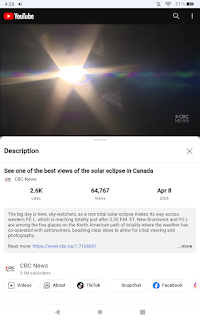Today our sky is full of unique magic, a total solar eclipse is occuring over Mexico, the United States of America, and Canada. "Total solar eclipses provide rare opportunities for scientists to observe the Sun’s corona (outer atmosphere), where the solar wind originates. These observations help scientists predict space weather events that may impact human and robotic space exploration, and affect the technology on Earth that humans rely on every day. Source: https://www.nasa.gov/learning-resources/nasa-releases-new-solar-eclipse-educational-materials/
Basically, "when the Earth, Moon, and Sun line up in space, we can see an eclipse. NASA studies eclipses from the ground, in our atmosphere, and in space, influencing solar, planetary, and Earth science. A total solar eclipse happens when the Moon passes between the Sun and Earth, completely blocking the face of the Sun. The sky will darken as if it were dawn or dusk. Except during the brief total phase of a total solar eclipse, when the Moon completely blocks the Sun’s bright face, it is not safe to look directly at the Sun without specialized eye protection for solar viewing. Viewing any part of the bright Sun through a camera lens, binoculars, or a telescope without a special-purpose solar filter secured over the front of the optics will instantly cause severe eye injury. After the total solar eclipse on April 8, 2024, the next total solar eclipse that can be seen from the contiguous United States will be on Aug. 23, 2044. We can’t normally see the corona – the Sun’s outer atmosphere – because the Sun’s surface below it is so much brighter. But during a total solar eclipse, the corona becomes visible, offering unique opportunities to study it. When the Moon completely blocks the visible surface of the Sun during a total solar eclipse, viewers can remove their eclipse glasses. A total solar eclipse is the only type of solar eclipse where eclipse glasses can be momentarily removed. When a solar eclipse reaches totality, nocturnal wildlife sometimes wakes up, thinking that it’s nighttime, and non-nocturnal wildlife might think it’s time to head to sleep! From 1:00p.m. – 4:00 p.m. EDT watch on NASA+ " Source: https://science.nasa.gov/eclipses/future-eclipses/eclipse-2024/
Here are some photos from various youtube pages:
















No comments:
Post a Comment